What causes black dots on skin? Get insights on the reasons for tiny, itchy small spots on skin especially during pregnancy, after waxing, how to get rid of them and pictures.
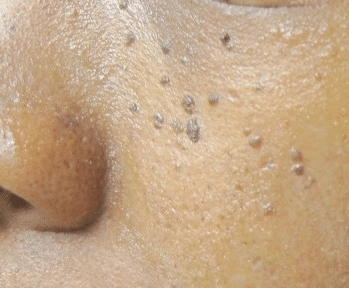
raised black dots on skin
Black Dots on Skin
This is as a result of the overproduction of melanin or skin pigment aging and UV light exposures which are the major causes. They majorly affect the following areas:
- The face
- The backs of the hands
- The shoulders
- The arms
- The back
Types of Black Dots on Skin
These are black dots caused by exposure to UV rays from the sun. The spots appear scattered in no particular pattern.
This type of black dots on skin is caused by hormonal imbalance especially in women might experience appearance on their cheeks during menstruation when their hormones are in flux or during pregnancy or menopause. It’s also a side effect of birth control pills and hormone therapy treatments. Melasma can also occur as a result of thyroid dysfunction
- Post-inflammatory hyperpigmentation
These are black dots that occur due to trauma to the skin which can be caused by psoriasis, burns, acne, and certain skin care treatments that are hard on the skin.
- Acne in Dark Skin
Acne can appear in any skin type due to its link to hyperpigmentation and it is of greatest importance for individual with dark skin. Acne grows when there is an overproduction of oil in the skin and it mixes with bacteria within the pores and blocks the pore opening which causes inflammation under the skin.Not only can this trauma lead to pigmentation problems in dark skin, but also medications used to treat acne. This is also true of certain oral antibiotics, particularly minocycline. In some people, it can produce a darkening of the skin, which can take months to fade.
- Pseudofolliculitis Barbae (PFB)
This skin condition is characterized by bumps below the surface of the skin and the problem actually stems from ingrown hair which often occurs in black and Hispanic people, due to the distinct shape of the hair follicle.
- Keloids and Dark Skin
Keloid occurs as a result of healing scar that appeared due to injury majorly around the earlobes, chest, back, and arms. Keloids can be removed via surgery or with a laser.
- Vitiligo in Dark Skin
It is as a result of skin depigmentation due to melanin-producing cells being damaged. The best way to treat vitiligo is through use of strong steroid creams which are effective if used on certain areas of the body such as the face and neck.
- Melanoma and Dark Skin
It appears especially where the skin is light such as the palms, soles of the feet, and around the nail bed. Since it is frequently misdiagnosed as plantar warts, tinea manuum , or a condition known as talon noir or black heel and because many people do not seek treatment early on, the melanoma death rate is highest among people with dark skin.
- Age dots
They are flat, brown, gray, or black dots on the skin. They usually appear on sun-exposed areas of the skin. Age dots are also called liver spots, senile lentigo, solar lentigines, or sun spots.
The following are ways to get rid of black dots on skin or are procedures to be followed in order to treat black dots on skin:
- Avoid excess exposure to the sun between 10 a.m. and 3 p.m., when the sun’s rays are most intense.
- Put on or wear a sunscreen daily which has a sun protection factor (SPF) rating of at least 15 and contain both UVA and UVB protection.
- Use sunscreen at least 30 minutes before sun exposure then reapply every two hours, more often if swimming or perspiring.
- Wear protective clothing such as hats, pants, and long-sleeved shirts. These help protect your skin from UV rays. For the best protection, wear UV-blocking clothes with an ultraviolet protection factor (UPF) of at least 40 or 50.
Black dots are not dangerous to the skin and don’t normally cause pain. On very rare occasions, black dots can make skin cancer more difficult to diagnose. The occurrence of black dots can cause emotional distress to some people. You can often remove or reduce them with treatment.
The dermatologist can prescribe bleaching creams so as to fade the black dots on skin slowly. These usually have hydroquinone, with or without the retinoids such as the tretinoin. Bleaching creams normally take many months to fade black dots. You will require putting on sunscreen at all times during the treatment. Bleaching and tretinoin creams make your skin more sensitive to UV dam dark.
According to research, the sudden occurrence of black raised itchy black dots on skin on the skin might indicate the presence of kaposis sarcoma, a skin cancer common to people who are infected with HIV. The appearance of the black spots can lead to early detection of the virus, which usually responds well to early diagnosis and treatment.
Tiny Black Dots on Skin
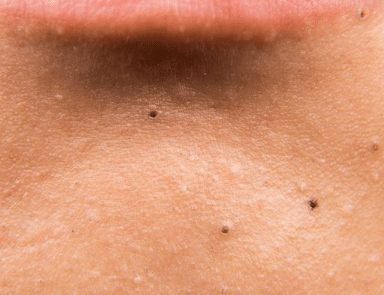
black dots on chin
These tiny black dots on skin are a very common skin problem found mainly in young adults who are at puberty. Although they are not a cause for alarm, they do look very nuisance and can be a major cause for a lack of self-esteem.
These tiny black dots are also known as hyper pigmentation which occurs when skin that has been exposed to direct UVR of the sun has an increase in melanocyte cell production, leading to a darkening of the skin.
These tiny black dots on skin most often appears on the parts of the body that have been exposed to excess sun such as the face, hands, back, and even the neck. These tiny black dots go by several names and can be named as brown dots, dark dots, sun dots, and liver dots. In some other cases they may be a sign of aging.
The following are major causes of tiny black dots:
- Overexposure to the sun is the major culprit for the black dots on skin to occur. Excess exposure to sun over time is almost guaranteed to result in dark dots.
- Aging also has a big part to do with black dots on skin. Those that are getting old and have had a lot of sun exposure in their life can really notice the start to show up when they hit around the age of forty. Lack of vitamins, the improper skin care, and stress are all very major contributors also.
- Again, those people who normally smoke cigarettes are also likely to develop the tiny black patches on skin. More serious conditions such as the cancer and diabetes are also some of the reasons dark spots can show up on the skin.
Small Black Dots on Skin
Dermatosis papulosa Nigricans are those small, black, slightly raised, mole-wart kind of a thing commonly found on the cheeks of a dark skinned person. It is neither a disease nor does it have any bearing on health since it is just a simple cosmetic problem as it looks unsightly to many of us and it can very easily be fixed by dermatologist.
Appearance of small black dots on skin is due to genetics, sun exposure and can cause the ones already occur to get darker. Individuals at age of 13 to 18 years tend to have growth of several small black dots on skin especially on the faces or neck.
These small black dots on skin appear similar to those of moles. The following are types of moles that appear to individuals at different stages of life:
- Congenital moles
This usually occurs at birth and they are very risky since they can result into skin cancer. They are also known as congenital mole, or congenital nevus.
- Acquired moles
They occur as a result of excess exposure to UVR of the sun. Most acquired moles will not develop into skin cancer.
- Atypical moles
They are also known as dysplastic nevi though they are larger than a pencil eraser and shaped irregularly. Atypical moles tend to run in families (are said to as a result of genetics) and they may be at increased risk of developing into skin cancer.
Itchy Black Dots on Skin
Dark brown and black dots on skin frequent with aging have the ability to turn into a very serious condition. According to Dermatology, an individual should monitor the black dots for any changes or itchiness that might indicate skin cancer.
In case they are notice at early stage they should be freeze off using a resurfacing procedure that may get rid of the dots. Malignant melanomas are characterized by the itchy black dots on skin that are very common in men and they tend to occur on the backs of the hands, face or even the neck. Left untreated, the cancer might spread to other parts of the body and prove fatal.
Those tiny black itchy dots found on the vulva can indicate an infection that should be immediately treated. The vulva is the fleshy outside skin that is around the vagina.
Vulvar cancers usually occur in women over the age of 60 and are treated by surgery. Prevention might assist to avoid any other vulvar infections. Common preventive measures include not wearing of very tight pants, keeping of the area clean and dry and avoiding douches.
Black Dots on Legs
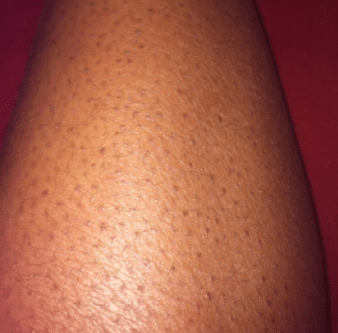
black dots on legs
Black dots on legs are an embarrassment especially to many women since they feel uncomfortable to adopt latest fashion which is ever changing due to taste and preferences. The following are the major causes of these dots:
- Leg Acne
It results due to hormonal imbalance such that the body is triggered to produce more protein or keratin which blocks the skin pores causing development of small bumps which contributes to black dots on leg condition is bacterial infection and the feeling of rough feeling of the bumps. After the bumps level they tend to turn black Keratosis pilaris will be found on thighs, on the sides of legs or tops of legs, and even on the buttocks.
- Solar Lentigo Age Spots
They appear due to hyperpigmentation which is caused by exposure to UVR rays from the sun and these radiations trigger the melanocytes to produce more melanin that is deposited to the top layers of the skin resulting to black dots on skin of the legs.
- Post-Inflammatory Hyperpigmentation
Melanin producing cells can react to increased inflammation i.e. releasing more melanin; after the skin is affected making it to deposits of melanin to the affected site where a black dot on leg skin suddenly appears.
- Warts
They are tiny and rough growth on the skin caused by human papillomavirus HPV. There are a number of warts but common wart is major cause of black dots on legs and feet or even face and hands.
- Moles
These are growths on skin that are appearing in clusters because of the failure of body cells to distribute out evenly on the skin. The growths will be found on any part of the human skin. Hereditary, moles tend to be black hence generating black spots on legs.
- Strawberry leg
This resulted due to poor shaving tools that cause the formation of ingrown hairs with slight inflammation around the hair pores leads appearance of very small bumps that may attract germs and bacteria.
- Papules
These are caused by acne, insect bites, flat warts or planter warts hence leading to formation of black dots on skin of the legs. Sometimes, insects might bite body which may take long to respond positively to the toxic substances hence leaving black scars as recovery takes course.
- Melanoma
According to some researchers, it is a kind of skin cancer that can appear anywhere on the body thus leading to formation of black dots on skin.
The following are ways to get rid of these nuisance black dots on the legs that can make individuals especially ladies to lack freedom on what to wear:
- Laser Treatments
It is non-surgical steps that utilize quality or pulsed light waves which are directed to affected area hence making it to be costly to the client. These techniques applied in laser to remove black dots on legs, allow these pulses of light to be absorbed by the cells, making them to disintegrate and get destroyed.
- Fraxel Dual Laser
This process only targets the extra melanin pigments and it ensures it removes black dots on the leg or feet without being absorbed by the surrounding melanin in other areas. It is advisable to visit a specialist before going for fraxel dual laser since it can have negative impact on the skin.
- Chemical Peels
These are minor peels that are safer for the skin on the front part because it tends to be lighter and thin. It is also, advisable to avoid deeper peels as they may cause serious problems to the legs instead of helping to remove black dots from legs.
- Dermabrasion
It is where a manual exfoliator tool is used together with some of the topical treatment creams such as the glycolic acid to assist to remove these black dots on the legs since these dead cells harbor black dots that have formed from deposited of excess melanin cells.
- Creams
Tropical creams are essentials in treating black dots on the legs since it reduce pigmentation. The following are the best cream that helps to get rid of black dots on the skin:
- Sonya Dakar Nutrasphere Fade Away,
- Mederma,
- Vita-K,
- Clinical Dark Spot Corrector
- Silicone Scar Sheets
They are usually available over the counter since its ability to stick meaning will have surmounting care of feet skin.
- Melapads and Melarase
For faster removal of pigments from bites begin a scheduled wear of melarase and Melapads in the morning and evening for black dots after insect bite.
- Retinol solution
Products like Retin-A and Renova are an alternate solution. They contain ingredients such as alpha-hydroxy acid and retinoic acid, which work to increase cell turnover, speed up exfoliation, and promote new, healthy skin growth.
Black Dots on Skin during Pregnancy
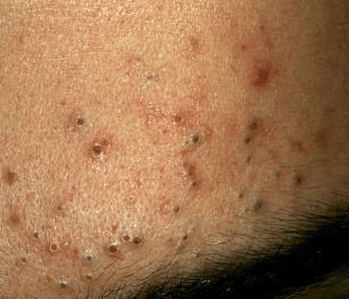
black dots on skin, face
Their appearance is due to the following:
- Mask of Pregnancy
This change occurs when the level of estrogen rises then it stimulates excess melanin production such that the freckles and moles may appear the black dots on the face starts to occur. The discoloration is temporary and usually disappears after delivery or, in some cases, after you finish breastfeeding.
- Ichthyosis Vulgaris
It occurs when dead skin cells to accumulate in patches on the surface of the skin resulting to fish scale disease such that during healing it causes appearance of black dots scars on skin.
- Exposure to direct UVR from sun
This is crucial because exposure to the sun’s ultraviolet (UV) rays intensifies pigment changes. When you’re outside, cover up and wear a hat with a brim, as well as a shirt with long sleeves if you have pigmentation changes on your arms.
- Facial Creams
Women who are pregnant are prone to irritation when they apply facial creams that are not from a reputable manufacturer causing appearance of black dots on their faces even on the neck.
- Concealing Makeup
Avoid using excess makeups especially during pregnancy periods but good news is, they usually go away after delivery.
During pregnancy, many women develop blotches of dark skin upper lip, nose, cheekbones, and forehead, which resemble somewhat the shape of a mask. Medically known as chloasma or melasma gravidarum, this condition is fairly more pronounced in women who have dark skin. Hereditary is also assumed to play a role.
Prevention of Skin Pigmentation In Pregnancy
- Pigmentation in pregnancy can be slightly minimized by using sunscreen, even when you are not out in the sun.
- Do not use new products on your skin during this time
- Avoid self-medication.
- Breastfeed for longer period.
Black Dots on Skin after Waxing
These are caused by the following:
- Using a pair of Tweezers that are not sterile when plucking ingrown hairs such that can result into growth of pimples that have black dots at their tops.
- It can also result due to over epilation which is caused by accumulation of dead cells.
Waxing has the following side effect on an individual especially in men. They include:
- Loss of Skin Suppleness and Elasticity: This one of the long term waxing side effect. It is observed that skin losses its elasticity and suppleness due to regular and prolonged use waxing. This generally occurs because of the ripping off the applied wax used during waxing.
- Wrinkle Formation: The second commonly observed long term waxing side effect. Regular waxing increases the risk of wrinkle formation. As the skin tends to loose its elasticity and suppleness gradually it develops wrinkles.
- Irritation and Redness: This is one of most commonly seen side effect associated with waxing. It is observed that many people develop irritation and redness of skin soon after waxing. Though skin irritation and redness could be subsided with the application of ice on the affected area.
- Skin Rashes, Reddish Bumps and Slight Subcutaneous Bleeding: These waxing side effects are generally observed in people with highly sensitive skin. Even the sensitive body parts like bikini area also show such waxing side effects.
- Skin Darkening and Burns: When waxing is done with overheated wax it may result in skin darkening and burns. Application of overheated wax may result in reddish brown spots. These spots appear as a result of post-inflammatory pigmentation. Mainly depending of the type of skin it might take a week to 1 year for pigmentation to fade out.
- Skin Infection: This waxing side effect mainly appears due to the application of infected or unclean waxing products for the procedure. Remember that diabetic people should avoid waxing because their skin is more susceptible for skin infection especially to deadlier and resistant bacteria.
- Allergic Reactions: This side effect of waxing is generally observed in people with wax and its product allergy. Allergic reactions may include severe skin rash to folliculitis. It is also seen that people with sensitive skin also develops pustules in the waxed area. It is advisable to you to visit your dermatologist immediately on the development of allergic reaction. In case your skin is sensitive and you are trying waxing for the first time then it is better to go for a patch test of wax.
- Ingrown Hairs: The problem of ingrown hairs is also referred as Pseudofolliculitis. Basically the major reason for the development of this waxing side effect is that waxing is done in the opposite direction of follicle.
How to Get Rid of Black Dots on Skin
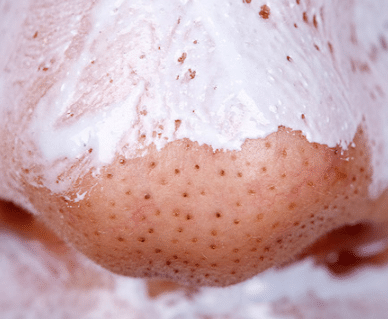
how to get rid of black dots on skin nose
There are many steps of how to get rid of these nuisance and embarrassing black dots on skin such as:
- Lemon Juice + Turmeric & Yoghurt
Make a mixture of lemon and turmeric together with yoghurt then apply and let it stay for about 20 minutes though it will take time to get rid of black dots on skin despite lemon and turmeric having good and natural bleaching quality that will enhance to get rid of black dots naturally.
- Strawberry Foot Scrub
Use a mixture of almond or olive oil with sea salt to the paste of strawberry then apply to the affected area frequently until the black dots disappear.
- Shea Butter
It is full of vitamin E which is very useful for the skin on the feet thus it is advisable to apply Shea butter sparingly before going to bed since it helps to lighten black dots on the bottom of foot. Wash with lukewarm water while scrubbing gently using a pumice stone and see your dark spots under feet disappear.
- Castor Oil, Grape seed Oil or Vitamin E Oil
It is another reliable way to remove black dots by applying castor oil on the legs to get black dots on feet and hands free of pigmentation.
- Horseradish
Make a horseradish mixture of Apple cider vinegar and let it settle for about 10 days then filter out the mixture thus rub on areas affected around the legs.
- Aloe Vera & Honey
Make naturally ingredients extract the apply on the affected areas in order to get rid of black dots on skin.
- Sandalwood
It is another effective option since natural oils helps to clear black dots naturally. It even adds a healthy glow to your skin.
- Fruits
It can be used as an effective home remedy for black spots since the papaya is known to have a lot of good benefits, aside from the fact that it increases people’s bowel movements, it is also good for the skin.
- Eczema in Dark Skin
It is a skin condition is characterized by an itchy, red rash that appears on gradually and lasts a long time then can be triggered by stress, extreme changes in temperature, dry skin, plant allergies, or irritations caused by skin care or cosmetic ingredients. When eczema occurs as the result of an inherited tendency, it is known as atopic dermatitis.
Eczema is believed to occur twice as frequently in children with dark skin. One study found its incidence is higher in Mexican-American teens than either whites or blacks. Other research found a greater incidence in Chinese and Vietnamese babies, compared with white babies.
When eczema occurs in those with dark complexions, it presents a two-fold problem; it is often misdiagnosed, leading to long periods of no treatment or the wrong treatment. When not treated early on, it can increase the risk of pigmentation problems. Treatment for eczema consists of identifying and avoiding products that irritate skin. Use of moisturizer can help, along with steroid creams. Sometimes, ultraviolet light therapy is effective. It is essential to seek help as soon as possible for any red, itchy rash. Doing so will help avoid pigmentation problems.
- Milk to treat dark dots, black dots on the face.
The lactic acid in the milk exfoliates the skin and clears the facial skin pores and lightens the dark dots by following the steps below:
- Take the milk in a bowl. Dip the cotton ball in the milk then rub the cotton ball on the dark spot area
- Do it in a circular motion. Daily do it for 5 minutes. Do it until you get the desired results.
- Onion Juice to treat black dots on the face
Adopt the following procedures when dealing with black dots at home:
- Take the onion and grind it well. Take the paste in cotton cloth and squeeze the cloth in bowl onion juice is out.
- Dip the cotton ball in that juice and apply directly on to the dark dots and leave it for 5 minutes and wash with the warm water.
- Oats
Exfoliation of skin will be done in the best way by use of oats through the following steps:
- Take 2 spoons of oatmeal in a container.
- Add 2 tablespoon of lemon juice.
- Mix it well with two spoons of honey.
- Apply it over your face and slowly rub the fingers on your face in a circular motion. Do this for 3 minutes and then keep the paste over your face for 15 minutes. Wash the paste with Luke warm water and see the dead skin layer removed from your skin making the complexion normal.
- See a dermatologist for a diagnosis
The dermatologist will have a special magnifying lamp that they can use to take a close look at the skin to determine what’s the major cause of the black dots on skin.
- Rub skin with citrus.
Vitamin C helps slough off the top layer of skin without causing damage hence helps in treating black spots on skin.
Black Dots on Skin Pictures
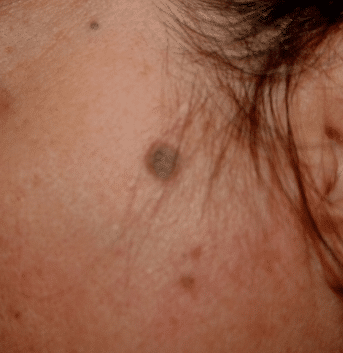
black spots on face
These black dots are usually an embarrassment to individuals especially to women than men such that it becomes a nuisance to them. The following are the major causes of black dots:
- Keloids
It is a bump of scar tissue that appears past a wound’s bounds and it may keep growing weak after the skin heals. More common in dark skin, keloids can form anywhere, but often they’re on earlobes, shoulders, the upper back, chest, or cheeks. They’re not harmful, so if they don’t bug you, you can leave them alone. But if one is too big or itchy, you can have it treated or removed.
- Skin Tags
They are little growths of skin with a bulge at the end and they usually form in places where the skin rubs together, like your neck, armpits, or groin. But if they’re painful, bleeding, or irritated.
- Skin Cysts
These small, flesh-colored sacs under your skin are filled with keratin. The slow-growing bumps form when a hair follicle or oil gland is blocked or damaged.
- Hives
Hives often fade within a day, but new ones can appear as the old ones go away leaving black dots of scars on the skin. There are a lot of things that can cause these itchy, swollen welts such as an allergy, infection, sun, exercise, stress, or an illness.
- Warts
They are caused by the human papillomavirus (HPV), but different strains affect only certain body parts and they are contagious also.
- Folliculitis
It causes small, red bumps or white-headed pimples and such that the bacteria may infect the hair follicles, often on your neck, thighs, armpits, or buttocks.
- Dermatofibroma
These bumps are harmless but they can bleed if they are prick since they have nerves and blood vessels causing black dots majorly on legs.
- Swollen Lymph Nodes
When there is an infection on the body parts, they an swell to pea-size lumps or larger and it results into weight loss, night sweats, fever, or fatigue, may be signs of cancer.
References
- What Causes Patches to Form?:http://www.healthline.com/health/patches#Overview1
- Skin problems and treatments : http://www.webmd.com/skin-problems-and-treatments/ss/slideshow-lumps-bumps-skin

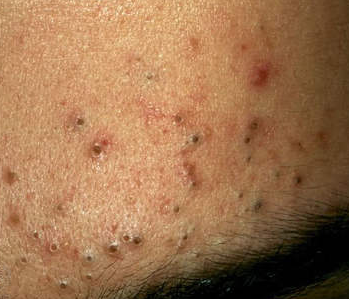
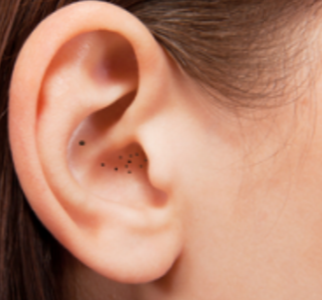
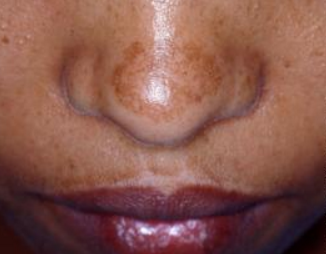
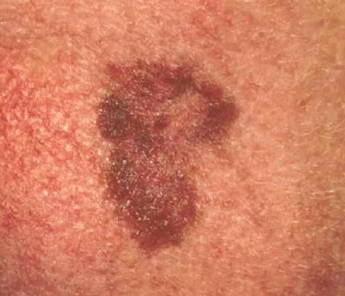

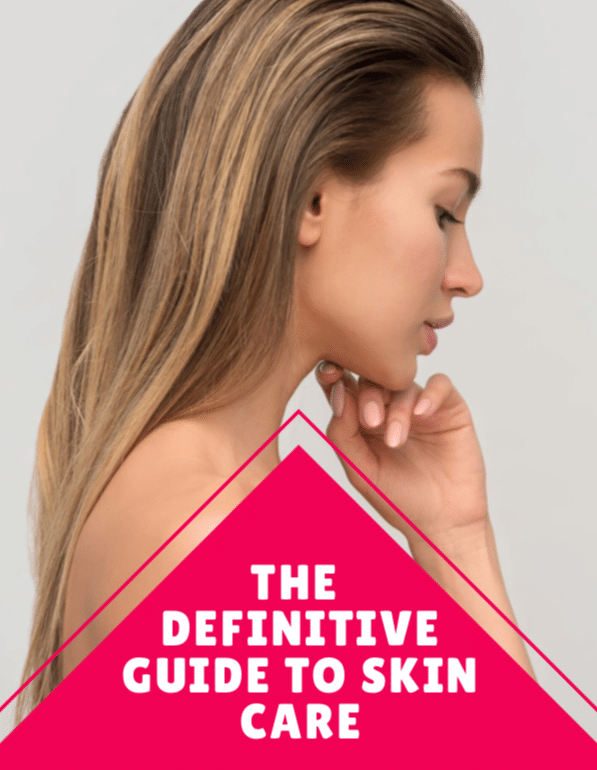








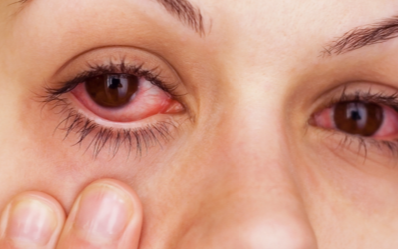


contentlion
October 18, 2016 at 8:38 pm
Acne responds effectively to melalecua, more generally recognized as
tea tree oil It’s utilized the world more than as an antiseptic and
to treat wounds.